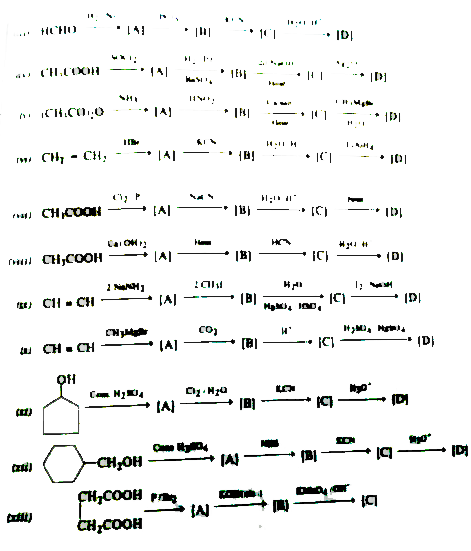Complete the following equations by writing the missing A, B, C, D etc.
(ii) C2H5OHPCl−−→AKCN−−→BH2O/H+−−−−−→Csodalime−−−−→DSolution in Bengali
A=C2H5Cl
B=C2H5CN
C=C2H5COOH
D=C2H6
Topper's Solved these Questions
- BOOK - NCERT BANGLISHCHAPTER - HYDROXY DERIVATIVESEXERCISE - SELF EVALUATION((A) Choose the correct answer :)24videos
HYDROXY DERIVATIVES
- BOOK - NCERT BANGLISHCHAPTER - HYDROXY DERIVATIVESEXERCISE - SELF EVALUATION((C) Answer not exceeding sixty words :)41videos
HYDROXY DERIVATIVES
- BOOK - NCERT BANGLISHCHAPTER - F-BLOCK ELEMENTS EXERCISE - SELF EVALUATION ( ANSWER NOT EXCEEDING 60 WORDS)4videos
F-BLOCK ELEMENTS
- BOOK - NCERT BANGLISHCHAPTER - ISOMERISM IN ORGANIC CHEMISTRYEXERCISE - SELF EVALUATION (CONFORMATION(Short answer questions.))2videos
ISOMERISM IN ORGANIC CHEMISTRY
Similar Questions
Which has the highest boiling point ?
View SolutionWhat are alcohols ? How do they differ from inorganic hydroxides ?
02:45View SolutionAccount for the following.
(i) +3 oxidation state of lanthanides is the most stable.
(ii) A few 4f elements show +2 or +4 oxidation states in addition to the characteristic oxidation state of +3.
(iii) Lanthanides are grouped together.02:56View SolutionDistinguish enantiomers and diasteromers ?
04:35View Solution(i) CH≡CHH2O−−−−−−−−−→H2SO4/HgSO4[A]o−−→[B]SOCl2−−−→[C]Benzene−−−−→AlCl3[D]
(ii) C2H5ClKCN−−→[A]H2O/H+−−−−−→[B]NH3−−→[C]Heat−−→[D]
 03:42View Solution
03:42View SolutionC_(2)H_(5)OHoverset(PCl_(5))rarr(A)overset(KCN)rarr(B)overset(H_(3)O^(+))rarr(C)overset(NH_(3))rarr(D)overset("heat")rarr(E)
View SolutionCH_(3)MgX underset(H^(+),H_(2)O)overset(CH_(3)-overset(O)overset(||)(C)-OC_(2)H_(5))(rarr)(A)overset(Na)(rarr)(B)overset(C_(2)H_(5)OH)(rarr)(C ),(C ) is :
03:42View SolutionIn the reaction sequence : C_(2)H_(5)OH overset(PBr_(3))(rarr) A overset(KCN)(rarr) B overset(H_(2)O^(+))(rarr) C C is :
View SolutionThe product D of the reaction CH3ClKCN−−→(A)H2O−−→(B)NH3−−→(C)Δ−−→(D) is
01:57View SolutionANH2OH−−−−→BH2SO4−−−→C260−270∘C−−−−−−−−−→H2OD
If 'D' is a polymer nylon–6 then 'A' can be :View SolutionThe product D of the reaction CH_(3)Cl overset( KCN) ( rarr) ( A) overset( H_(2) O) ( rarr) (B) overset( NH_(3))(rarr) ( C ) overset( Delta)( rarr) ( D ) is
View SolutionSOCl2−−−→(A)KCN−−→(B)H+−−→(C ), the compound (C ) is
 02:12View Solution
02:12View SolutionComplete the following equations by writing the missing A, B, C, D etc. (ii) C_(2)H_(5)OH overset(PCl)rarr A overset(KCN)rarr B overset(H_(2)O //H^(+))rarr C overset("sodalime")rarr D
View SolutionComplete the following equations by writing the missing A, B, C, D etc. (ii) C_(2)H_(5)OH overset(PCl)rarr A overset(KCN)rarr B overset(H_(2)O //H^(+))rarr C overset("sodalime")rarr D
02:23View SolutionComplete the following equations by writing the missing A, B, C, D etc.
(ii) C2H5OHPCl−−→AKCN−−→BH2O/H+−−−−−→Csodalime−−−−→D02:10View Solution

